On a normal day in Philadelphia, about 4,000 people are homeless, and over the course of a year, more than 3,500 young people resort to sleeping in an emergency shelter (Children’s Work Group 2010). Public health researchers have clearly documented a range of adverse health effects associated with housing insecurity and homelessness, including threats to mental, physical and social wellbeing (Bassuk 1997; Rouse 2009; Weinreb 1998; Ma 2008; Perlman 2010).
The artists and educators of Philadelphia’s Mural Arts Program (MAP) saw first-hand how this social problem affected the high-risk youth they serve in art education and life skills training programs. Over and over again, the MAP team recognized that their youth got into trouble—dropping out of school, not showing up for work, getting involved with the juvenile justice system—when their access to stable housing was threatened.
Committed to improving the lives of young people facing housing insecurity, MAP developed the arts and advocacy initiative: A Place to Call Home. A multidisciplinary team of artists, researchers, public servants, community members, the press, a real estate developer and, most importantly, 48 high-risk youth participating in Mural Arts programs, came together to create a mission statement that would define the path ahead:
Our mission is to engage and empower Philadelphia youth in order to understand how home, as they define it, contributes to—or takes from—their sense of wellbeing. In addition, we will increase awareness of how Philadelphia’s socioeconomic diversity contributes to the health and life chances of the city’s residents. These goals will be achieved through photo-documentation, storytelling, and art-making.
Over the course of six months, the MAP project team acted together on this mission, under the direction of Shari Hersh and lead artists Ernel Martinez, Shira Walinsky and Damon Reaves. The team adopted a systematic approach that included photo-documentation and photo-elicitation interviewing to organize this expansive collaboration (Cannuscio 2009). The first step was to photographically document housing conditions along Spruce Street, a major corridor cutting through the city, from Cobbs Creek to the Delaware River, adhering to a strict protocol. These photos generated team discussions regarding how housing conditions vary across the city’s socioeconomic gradient. Second, we gave cameras to the 48 high-risk youth and asked them to explore and document what home means to them from their “insider” perspective. Third, a group of researchers and newly trained artists and undergraduate students interviewed the youths, using each young person’s own insider images of home as the basis for photo-elicitation interviews. The interviews focused on the young people’s highly personal experiences of home and, in some cases, homelessness (Cannuscio 2012).
On a normal day in Philadelphia, about 4,000 people are homeless, and over the course of a year, more than 3,500 young people resort to sleeping in an emergency shelter (Children’s Work Group 2010). Public health researchers have clearly documented a range of adverse health effects associated with housing insecurity and homelessness, including threats to mental, physical and social wellbeing (Bassuk 1997; Rouse 2009; Weinreb 1998; Ma 2008; Perlman 2010).
The artists and educators of Philadelphia’s Mural Arts Program (MAP) saw first-hand how this social problem affected the high-risk youth they serve in art education and life skills training programs. Over and over again, the MAP team recognized that their youth got into trouble—dropping out of school, not showing up for work, getting involved with the juvenile justice system—when their access to stable housing was threatened.
Committed to improving the lives of young people facing housing insecurity, MAP developed the arts and advocacy initiative: A Place to Call Home. A multidisciplinary team of artists, researchers, public servants, community members, the press, a real estate developer and, most importantly, 48 high-risk youth participating in Mural Arts programs, came together to create a mission statement that would define the path ahead:
Our mission is to engage and empower Philadelphia youth in order to understand how home, as they define it, contributes to—or takes from—their sense of wellbeing. In addition, we will increase awareness of how Philadelphia’s socioeconomic diversity contributes to the health and life chances of the city’s residents. These goals will be achieved through photo-documentation, storytelling, and art-making.
Over the course of six months, the MAP project team acted together on this mission, under the direction of Shari Hersh and lead artists Ernel Martinez, Shira Walinsky and Damon Reaves. The team adopted a systematic approach that included photo-documentation and photo-elicitation interviewing to organize this expansive collaboration (Cannuscio 2009). The first step was to photographically document housing conditions along Spruce Street, a major corridor cutting through the city, from Cobbs Creek to the Delaware River, adhering to a strict protocol. These photos generated team discussions regarding how housing conditions vary across the city’s socioeconomic gradient. Second, we gave cameras to the 48 high-risk youth and asked them to explore and document what home means to them from their “insider” perspective. Third, a group of researchers and newly trained artists and undergraduate students interviewed the youths, using each young person’s own insider images of home as the basis for photo-elicitation interviews. The interviews focused on the young people’s highly personal experiences of home and, in some cases, homelessness (Cannuscio 2012).
A Public Art Installation in Mantua
A Public Art Installation in Mantua
In the photo-elicitation interviews, the young people were forthcoming about the insecurity of their home lives and how they frequently relied on temporary solutions, such as staying with extended family or friends, or at shelters, in lieu of stable housing. The stories revealed in photo-elicitation interviews were the genesis of a range of multi-media art installations on and around Melon Street in Philadelphia’s Mantua neighborhood. There, a developer from West Philadelphia Real Estate donated an abandoned row home that the team revived and turned into an Art House—filled outside and in with art inspired by the young people’s stories about the meaning of home. In addition to art, the house also provided practical information and resources regarding housing, jobs, education and social services, for the benefit of the young people themselves as well as the local community and visitors to the Art House.
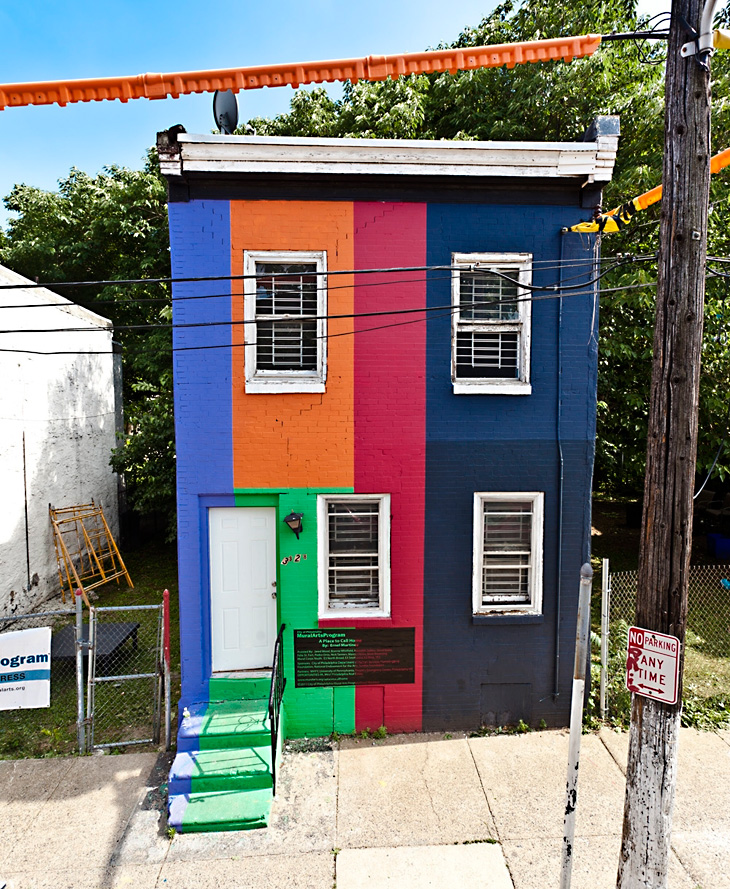
Photo by Steve Weinik
Photo 1. An abandoned row home on Melon Street was transformed from a drug house into an Art House containing multi-media installations based on young people’s stories of housing insecurity and homelessness.
The Art House itself became part of a block-long mural on Melon Street, envisioned and created by artist Ernel Martinez, who engaged neighbors in intense conversation and negotiation regarding how their individual homes and their block should be visually transformed. This process, which Martinez saw as an important part of the art itself, built trust among neighbors in a place where trust had long been undermined by the challenges of poverty, violence and an active local drug trade. Through his intensive efforts and communication, Martinez successfully integrated almost every house on the block into his artwork; now the mural stands as a visual symbol of the connections among neighbors. Martinez rejected the idea of an iconic mural for this project, instead developing a conceptual work that emphasized continuity and community while retaining the individual identity of each home.
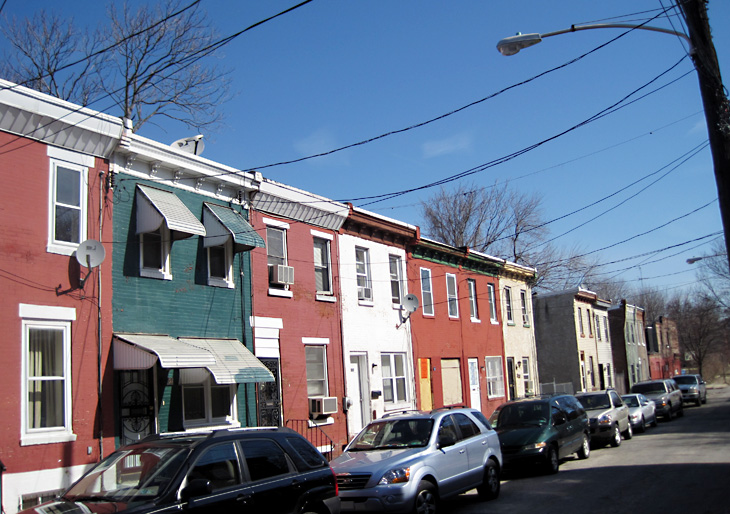
Photo by Steve Weinik
Photo 2. Melon Street before its transformation during the Mural Arts Program’s installation in A Place to Call Home.
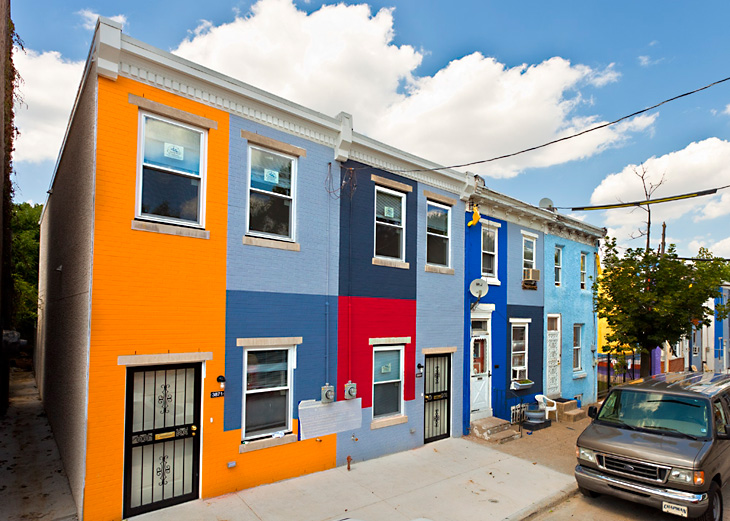
Photo by Steve Weinik
Photo 3. Melon Street after artists, neighbors, students and volunteers worked together to create the block-long mural designed and directed by artist Ernel Martinez.
Artist Shira Walinsky emblazoned nearby row homes with a series of vivid murals incorporating symbols of security, shelter and comfort—themes that frequently emerged during the project’s photo-elicitation interviews. The strong colors and bold images Walinsky chose for these works conveyed the pivotal importance of domestic life. Walinsky’s murals encouraged the local community to initiate conversations about the meaning of home. She augmented her large-scale works with smaller wheat-pasted murals—signs that called up the universal need for heat, food, water and shelter. Together, these works formed a path to the Art House and offered repeated opportunities for neighbors to reflect on home as an essential component of human dignity.
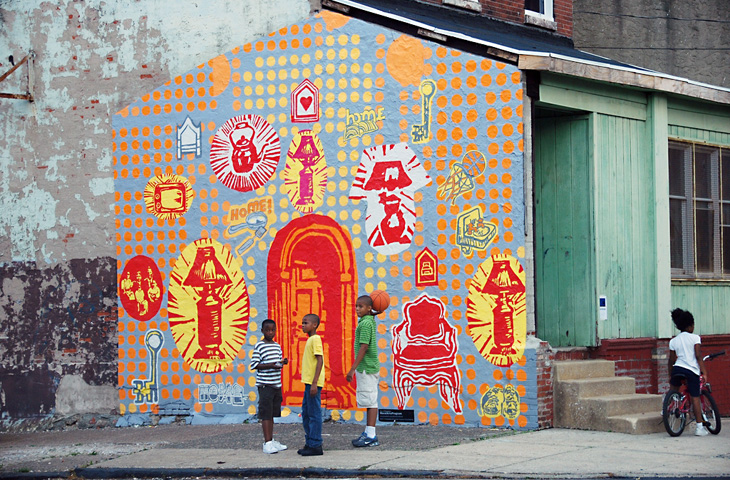
Photo by Steve Weinik
Photo 4. Artist Shira Walinsky created a visual path to the Art House on Melon Street with a series of murals emphasizing the central importance of housing security to individuals, families and the Philadelphia community.
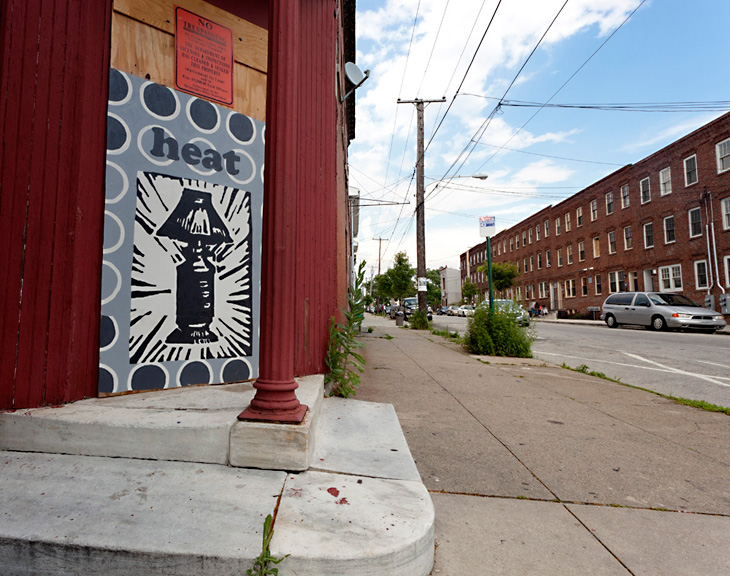
Photo by Steve Weinik
Photo 5. Shira Walinsky’s small-scale murals and wheat-pasted prints offered bold visual reminders of our community’s most essential needs.
These themes resounded within the Art House, where Martinez installed furniture literally crafted out of the transcribed interviews with the high-risk youth. A dining table, chairs, wallpaper and dinnerware were all sculpted from paper, conveying the actual stories shared by the youth and also metaphorically underscoring the insecurity of home for many of these youth. While the dining set appeared sturdy and inviting, in reality it was highly fragile. In adjoining rooms, stop-motion animation by Damon Reaves wove together images of a classic Philadelphia row house, including its active interior life, with audio recordings from youth interviews. These animations contrasted images of domestic comfort with the struggles that youth encounter as they attempt to identify secure housing—often for themselves and for family members who depend on them for support. Upstairs, prints and an audio mural by WHYY’s Elizabeth Perez Luna offered the visitor an immersion in the life experiences of youth struggling to find a place to call home (Perez-Luna 2011).
What Elements of the Project Worked?
What Elements of the Project Worked?
The team reflected on what elements of the project advanced the mission of “engaging and empowering Philadelphia youth in order to understand how home, as they define it, contributes to—or takes from—their sense of wellbeing.”
The project had a clear structure and applied a tested method. This project was structured to include documentary photography, photo-elicitation interviewing, community engagement and art-making. The approach offered a strong model (Cannuscio 2009) that allowed artists, researchers, a real estate developer, public servants and concerned citizens to connect with and hear the housing-related concerns of high-risk youth and the Mantua community. The method was disciplined and brought order and a sense of direction and purpose to the project, so that the group could move together toward the goal of hearing the young people’s stories and then amplifying their voices through public art.
The issue of housing resonated for the young people, and they stayed involved in the project for its duration. The youth were deeply engaged in the storytelling and art-making. They were mentored closely by accomplished artists and educators throughout the process. The youth spoke passionately over several months about their concerns regarding housing and home, their own wellbeing, and the health of their peers. Through their commitment to this project, the youth demonstrated that these issues are central to their identity and the sense of possibility in their lives. They used the project as an opportunity to connect with local housing resources and with concerned adults. The MAP team fostered youth commitment by engaging and empowering them at every step of the project. Participants’ photographs guided their photo-elicitation interviews, and the themes that emerged from their interviews inspired Martinez, Walinsky and Reaves’ art. Participants helped edit their own interview transcripts. Some young people even participated in the artistic process by collaborating with MAP artists, helping transform abstract ideas about home and security into art. The artists, researchers, and team members believed that: 1) the young people felt truly heard during the course of the project; and 2) engaging the youth through active conversation and close listening prepared them to contribute meaningfully to the team’s efforts on Melon Street.
The issue of home is universal and spoke to all members of the project team. Because the issue of home is of universal importance, every contributor had a valuable perspective and a personal history to add. This fueled conversations and energized the artists as they transformed wide-ranging stories into inspired multi-media installations that resonated in the community.
Artists, students, staff and research team members developed new skills that allowed for effective engagement. The project team, which included a group of approximately two dozen undergraduate students from Jane Golden and Shira Walinsky’s community murals class at the University of Pennsylvania, developed new skills in photo-elicitation interviewing and the use of human stories in the creation of public art. Artists, administrators, and assistants were also trained in interview methods. These students—and the whole team—found a meaningful way to step outside the classroom or the everyday structures of work in order to engage with the local community and to reflect upon the experiences of the 48 youth involved.
Change was sparked in a neighborhood that has long struggled with a range of social and economic issues. The changes in the community were both metaphorical and physical. Community members were given a voice, and were given a say in the physical transformation of their neighborhood; they initiated new relationships and found a renewed sense of connection to their own homes and block. Mural Arts was well-positioned to bring diverse city resources to the block, which demonstrated to the residents of Melon Street that the city can serve them, even as they engage in change to help themselves.
Social services were delivered in a vibrant setting that worked to attract participation and reduce stigma. The project created awareness about the importance of housing, and about pervasive community concerns regarding housing insecurity. Stigma and shame were reduced through sustained dialogue across the project team, in interview dyads, and in public forums—including the well-attended dedication of the Art House and Melon Street mural. The project inspired many of the youth involved to reach out for help. Youth participating in the project encouraged their peers to get involved as well, and to seek help and services for their housing needs. Residents of Melon Street and visitors to the Art House were also invited to share in the information and social service resources provided through the project.
Public life was rekindled on Melon Street. When the team first started on the street, there were abundant signs that home was a struggle, a burden and a source of concern. Facades were fading and in some cases crumbling; windows were broken; lots were vacant and unkempt. And most importantly, the street was silent and deserted, with very few people venturing outside into the shared community spaces. The team hoped that, as a first step toward community change, the physical space would be transformed. As artist Ernel Martinez reflected on the project, he commented that sometimes the art is in the mural—in its colors and forms—and sometimes the art is in the process—in the coming together of once-distant neighbors to revitalize the space they share and call home. This latter art—fostered in large part by the dedication of the lead artists themselves—was evident on an active community paint day, with residents across generations participating. It was also apparent when the exhibit opened: There was life on Melon Street, with hundreds of people—including all of the 48 originally involved high-risk youth—coming together to witness the change. They were there to join their voices together regarding the meaning and challenges of housing and homelessness.
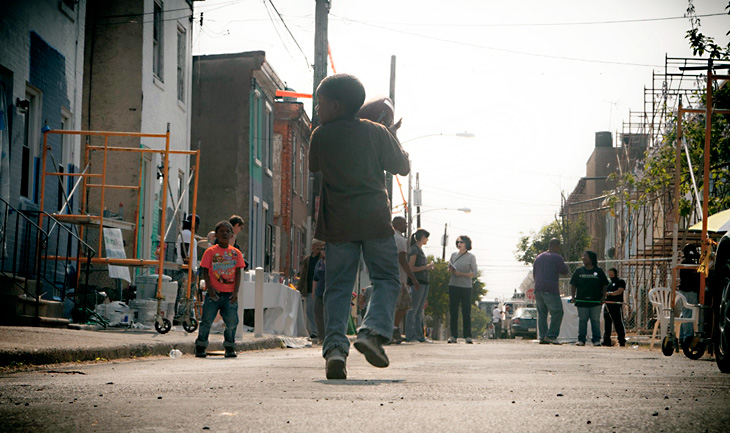
Photo by Steve Weinik
Photo 6. The public space was renewed, socially and physically, on a community paint day on Melon Street.
What is Next?
What is Next?
The project team is convinced that this work has only just begun. In the future, the team will continue working to understand local residents’ concerns regarding housing insecurity and the meaning of home. One plan under consideration is to select some of the 48 young people who were originally interviewed for the project so that they can assist in interviewing additional community residents. The team also hopes that the Art House concept will be revived to provide an ongoing “third place” where community residents can gather to learn, generate art and nurture social relationships among neighbors. In addition, the Art House will serve to connect residents of the immediate neighborhood and the broader Philadelphia community. Though this step is in the planning phase, the concept is to solicit community-generated suggestions for how the Art House can best be used to showcase and develop the talents and skills (artistic and otherwise) of the community. The artists from this project described a strong desire to foster the assets of the neighborhood and its youth, particularly through efforts focused on education, economic development and job readiness. For example, the Art House may be used as a location for workshops, to provide solid skills and opportunities for the youth of the neighborhood. Potential workshops include college preparatory work, or helping youth find internships.
In sum, this project brought together a diverse project team to address the centrality of home in all lives, including the lives of high-risk youth. The team encountered young people and a community eager to discuss issues of housing insecurity and homelessness. A few months after wrapping up the first stage of A Place to Call Home, the project team received a note from the block captain of Melon Street, the project site in Philadelphia's Mantua neighborhood. She wanted to tell the team about the changes she saw afoot in her community. People were sprucing up their homes, paying attention to upkeep, and even buying new windows and doors. These seemingly mundane tasks were interpreted as a watershed by the project team, given the daunting challenges of Melon Street and the surrounding community. Residents, young people, artists and researchers have seen that change is possible. Much work remains, however, and more can be accomplished if all of these groups continue to work together to combine art, research and advocacy as tools to advance the mission of A Place to Call Home.
Carolyn Cannuscio is a social epidemiologist and a Core Investigator at the Center for Health Equity Research and Promotion at the Philadelphia VA Medical Center. She is also an Assistant Professor in the Department of Family Medicine and Community Health at the University of Pennsylvania Perelman School of Medicine.
Eva Bugos is with the Mixed Methods Research Laboratory and the Center for Public Health Initiatives, University of Pennsylvania. She is an undergraduate at the University of Pittsburgh.
Katie Kellom graduated from Bryn Mawr College in 2009 with a degree in Psychology. She currently works as a Research Assistant for the Mixed Methods Research Lab pursuing her interests in health behavior, community structures, and social deviance.
Shimrit Keddem is the manager of the Mixed Methods Research Lab at the University of Pennsylvania School of Medicine. She provides managerial and technical support and expertise on qualitative and mixed-methods research to faculty, staff and trainees. Shimrit has a background in psychology and a Masters in Urban Spatial Analysis from the University of Pennsylvania.
Shari Hersh serves as Mural Arts' Senior Project Manager. Building on 13 years of experience at the organization, she is currently responsible for project development and management with a focus on socially engaged projects that highlight youth involvement and utilize collaborations with institutional and community partners.
Jane Golden serves as Mural Arts' Executive Director and has overseen the organization's grwoth from a small city agency into the nation's largest mural program and a model for community development. Under Golden's direction, Mural Arts has created over 3,500 landmark works of public art through innovative collaborations with communities, grassroots organizations, city agencies, schools and philanthropists.
Elizabeth FitzGerald is a research coordinator at the University of Pennsylvania. She has expertise in visual research methods.
References
References
Bassuk EL, Weinreb LF, Dawson R, Perloff JN, Buckner JC. Determinants of behavior in homeless and low-income housed preschool children. Pediatrics 1997;100(1):92-100.
Cannuscio CC, Weiss EE, Fruchtman H, Schroeder J, Weiner J, Asch DA. Visual epidemiology: Photographs as tools for probing street-level etiologies. Social Science & Medicine 2009;69(4):553-564.
Cannuscio C, Bugos E, Hersh S, Asch DA, Weiss EE. Using ART to AMPLIFY Youth Voices on Housing Insecurity. American Journal of Public Health 2012;102(1):10-12.
Children’s Work Group. (2010, August 26). Philadelphia Children and Youth Experiencing Homelessness. Available at https://www.pccy.org/userfiles/file/ChildWelfare/HomelessChildrenReport2010.pdf.
Ma CT, Gee L, Kushel MB. Associations between housing instability and food insecurity with health care access in low-income children. Ambulatory Pediatrics 2008;8(1):50-57.
Perez-Luna, E. (2011, June 17). How teens see ‘home,’ even when they lack one. NewsWorks. Available at http://www.newsworks.org/index.php/a-place-to-call-home/item/21647-how-teens-see-home-even-when-they-lack-one.
Perlman S, Fantuzzo J. Timing and influence of early experiences of child maltreatment and homelessness on children's educational well-being. Children and Youth Services Review 2010;32(6):874-883.
Rouse HL, Fantuzzo JW. Multiple risks and educational well being: A population-based investigation of threats to early school success. Early Childhood Research Quarterly 2009;24(1):1-14.
Weinreb L, Goldberg R, Bassuk E, Perloff J. Determinants of health and service use patterns in homeless and low-income housed children. Pediatrics 1998;102(3):554-562.


